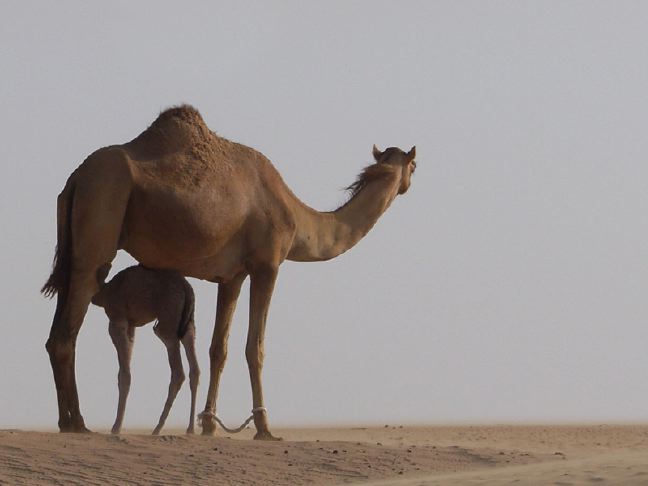|

Image Source: Shawn Allen
/ License under Creative Commons
2.0
Available in two desktop sizes:
1024 x 768 || 800
x 600
Most of the Arabian Peninsula is desert; and, of this, one-third is "sand desert."
Starting in the north of the peninsula, we find the Great Nafud desert, which covers
more than 40,000 sq mi. (103,600 sq km), forming an oval depression. [15] The Dahna Desert, a narrow corridor of gravel
plains and sand dunes, stretches 398 mi. (640 km) south from the Nafud to the Rub'
al Khali. [16] The gravel plain of the Dahna is formed when the sand is blown away, leaving
only the large gravel behind. To the south the Rub' al Khali (empty quarter) is one
of the world's largest sand deserts, encompassing the southern third of the Arabian
Peninsula. It covers 250,000 sq. mi. (650,000 sq. km), more than the combined land
mass of the Netherlands, Belgium, and France. Summer temperatures climb to nearly
131°F (55°C) at noon. With some dunes taller than the Eiffel Tower - over
1000 ft. (305 m)- this desert is one of the most inhospitable environments on Earth.
[17] The al-Murrah tribe with some 15,000 members still wander along the fringes
of the Rub' al-Khali. In the desert, the distance between watering holes means they
can only raise herds of camels. During the rainy season (December-January), the al-Murrah
migrate into the desert areas. But, the start of the dry season (April) will force
them back towards cultivated lands. [18]


A camel and her calf.
Image Source: HISHAM BINSUWAIF
/ License under Creative
Commons 2.0
Available in two desktop sizes:
1024 x 768 || 800
x 600
A mature camel (6-7 years old) weighs between 551 lbs. (250 kg) to 1500 lbs. (680
kg), and stands from 6 ft. (1.8 m) to 6 1/2 ft. (2 m) tall at the shoulders. A camel's
thick wool can make it appear larger, especially during the winter. [19] Their head and body length is 10 ft. (3 m),
not including a rope like tail which is over 20 in. (50 cm) long. [20] [21] Camels have two toes on each foot, each with
a hoof on the front that looks like a toenail. They walk on their toes much like
a woman wearing a pair of high heels. But, instead of a heel, a camel has a ball
of fat that helps form the soft pad on the bottom of its foot. This pad supports
the animal on the sand like a pair of snowshoes, and makes the camel almost completely
silent when it walks and runs.


A camel's foot.
Image Source: Kazuhisa OTSUBO
/ License under Creative Commons
2.0
They also have callous like pads on their chest, the back of their front leg joints,
and the front of their back leg joints. These pads cushion the animal when it kneels
down and keeps it comfortable while it is resting on the ground, even on hot sand.
The pads are made of tough leathery skin that looks as though the hair has been rubbed
off. These pads are natural, however, and not a sign of wear. They start developing
after the camel is born and become tough at about five months old. To get up, a camel
must first straighten its hind legs and then jerked up its front legs. This allows
the camel to lie down and get up, even when heavily loaded. [22]
|